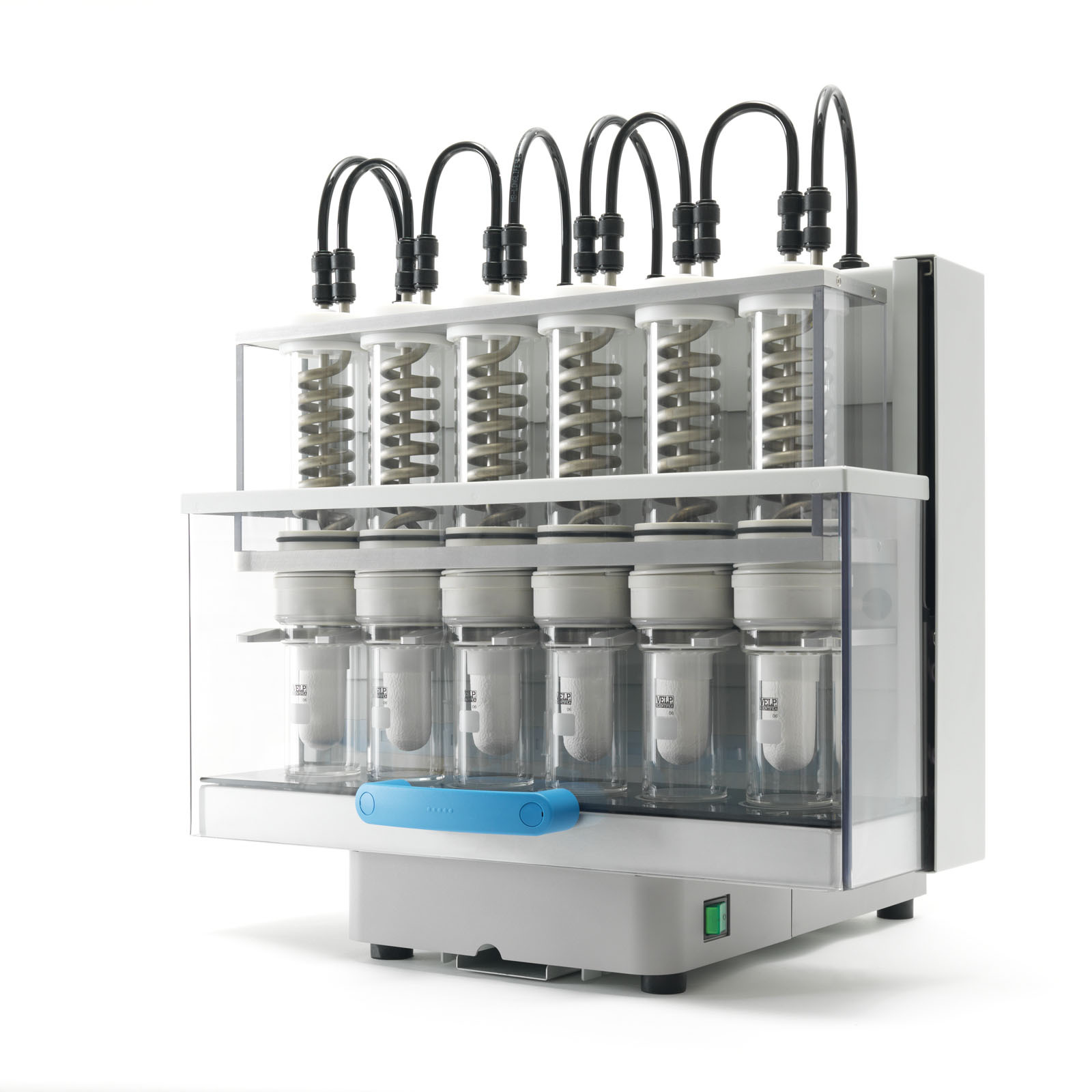方案详情
文
奶酪是钙和蛋白质的重要来源,采用SER158脂肪测定仪(溶剂自动萃取仪)和HU6水解装置测定干酪中脂肪含量,结果可靠,重复性好,与期望值一致,相对标准偏差((RSD < 1%),表明结果具有较高的重复性。
方案详情

APPLICATION NOTEF&F-S-001-2018/A1 TOTAL FAT DETERMINATION IN CHEESERANDALLMETHOD Total Fat Determination in Cheeseaccording to the Randall method Reference: AOAC 933.05 Fat in Cheese Tested with VELP Scientifica SER 158/6 Solvent AutoExtractor (Code S303A0380) and HU6 Hydrolysis Unit(Code F30300110) Introduction Cheese is a great source of calcium and protein. It also contains high amounts of vitamins A and B12, along with zinc,phosphorus, and riboflavin. Cheese is also a high-fat and high-calorie food. Indeed types of cheese are often classified according to the fat content, andthe dough of the cheese changes accordingly from soft to hard. Anyway, there is nothing so bad that it is not good for something: fat in cheeseis indeed what carries the flavors, and makes the lipid-soluble vitamins A, D,E and K accessible to the body. Fat % d.m.* Classification Dough > 45 High fat Hard 25-45 Medium fat Semi-hard 10-25 Low fat Semi-soft <10 Skim Soft High-fat cheeses like blue cheese, Brie, and sharp cheddar contain also smallamounts of conjugated linoleic acid (CLA). This is a fatty acid that naturallyoccurs in foods, and it has been shown to be anti-carcinogenic, besidespreventing heart disease and obesity. *d.m.= on dry matter Fat Determination in Cheese Hot solvent extraction process with SER 158 Series can be summed up in 5 steps, for a fully automatic process completelyunattended: During IMMERSION the sample is immersed in boiling solvent. Then the REMOVING step automatically lowers the levelof the solvent to below the extraction thimble. During WASHING the condensed solvent flows over the sample and throughthe thimble to complete the extraction process. The fourth step involves solvent RECOVERY. Approximately 90% of thesolvent used is collected in the internal recovery tank. The final step is the COOLING of the extraction cups containing theextracted matter. The cups are raised to prevent burning. The extraction cups containing the extract are placed in a dryingoven, cooled in a desiccator and weighed for the extract percentage calculation. Sample Semisoft cheese Fat labeled content: 22% In order to determine the total fat in food and feed samples a direct extraction with solvents is not efficient because a partof lipids is chemically bonded with other components. The determination of the total fat content of these samples, requiresa preliminary hydrolysis using hydrochloric acid 4 N, followed by filtration and washing, in order to free completely the fatmolecules. Then the hydrolyzed sample is ready for the extraction and it can be easily transferred to SER 158 SolventAutoExtractor avoiding any possible sample loss and ensuring improved accuracy of results (see the following picture). Chemicals and Equipments Required Analytical balance, min. 3 decimalsTest tube 250 ml (Code A00000144)Glass sand, 0.4-0.8 mm (Code A00000089)·(Glass bottle for waste collector (Code A00000088).Celite 545 (Code A00000097)Glass extraction cups (Code A00000290)GGlass crucibles P1 (Code A00000086)Viton sealsHHydrochloric acid 4NPetroleum Ether40-60 °C as solvent All the accessories required for the hydrolysis are included in the kit code A00000085. Sample Preparation ●HHydrolysis Crucibles Preparation Put 25 g of glass sand in glass crucibles P1 and 3 g of Celite 545: the two layers resulting have not to be mixed togetherotherwise the phase in Celite may bypass the crucible negatively affecting the end result. · Sample Preparation in Test Tube Mix the sample with a spoon and weigh 3 gof homogenized sample (Msample) and 2 g of Celite 545 in the test tube. In eachtest tube add 50 ml of 4N hydrochloric acid, shake gently and carefully, and finally add a further 50 ml hydrochloric acidin order to rinse the sample residue that may remain on the walls of the test tube. Glass Extraction Cups Preparation Keep the empty glass extraction cups in oven at 105 °℃ for 1 hour. Cool them in a desiccator and record the accurateweight of the tare (Mtare). Hydrolysis Procedure with HU 6 Place 6 crucibles P1 on the HU6 and connect the aspirating tubes: one side needs to be placed on the sealing ring ofthe crucible and the other one has to be in contact with the corresponding test tube.Set 170 °C for 30 minutes. Place the 6 test tubes in the heating block, lower the glassware and activate the vacuum pump. . In case of foam, add 4 N hydrochloric acid drop by drop inside the test tubes. At the end of the procedure, switch off and allow aspiration of the content of the test tubes in the crucible.Raise the glassware to its maximum point and secure it, by tightening the knob. Then, add hot water (40-50 °C, about 250 ml) slowly, in order to aspirate all the residues of hydrolysis in the test tubes.Remove the aspirating tubes and the crucibles containing the sample after the washing: mix the layer of hydrolyzed sample with the layer of Celite by using a spatula in order to break any clot. Be careful not to damage the layer of glass sand. This operation helps the sample drying, which must take place in an oven at 105°C. lf dried test portions will not be immediately extracted, put them in a desiccator, or let the crucibles cool to roomtemperature and then, mix the layer of hydrolyzed sample and Celite with a spatula to obtain a powdery hydrolyzed Be careful not to damage the layer of glass sand. Extraction Procedure with SER 158 Fix the crucibles with the crucible holders (Code A00000293). The extraction cups containing the crucibles can now beplaced on the ultra-fast heating plate of SER 158. . On the ControlPadTM select“Analysis”, and then method“Total fat in cheese" including the following parameters: ●· Immersion Time: 60 minutes Recovery Time 30 minutes ●RRemoving Time: 10 minutesCooling Time: 3 minutes●VWashing Time: 50 minutesPetroleum Ether 40-60 °C, 100 ml Close the safety guard and add the solvent using the automatic solvent dispensing system SolventXpressTM to minimizeexposure to the solvent ensuring operator safety. Press START to begin the extraction process. At the end of analysis position the extraction cups containing the extract ina drying oven(1 hour at 105°C), cool them in a desiccator to room temperature and record the accurate weight (Mtot). TOTAL FAT DETERMINATION IN CHEESERANDALLMETHOD Typical Results on Cheese Analysis results are calculated automatically and stored in the ControlPadTM when entering the weights into the software(manually or automatically through a balance). The extract percentage calculation is performed by using the followingformulas: Where: Sample= sample weight (g) Tare= weight of the empty extraction cup (g) Total =weight of the extraction cup +extract (g) Tare (g) Sample (g) Total (g) Extract (g) Extract (%) 133.5103 5.0782 134.6117 1.10 21.7 134.4137 5.0895 135.5335 1.12 22.0 133.3980 5.0115 134.4984 1.10 22.0 135.0785 5.0655 136.2112 1.13 22.4 133.4737 5.0421 134.5857 1.11 22.1 132.4648 5.0483 133.5793 1.11 22.1 Average±SD% 22.0±0.2 RSD%** 0.98 Fat Labeled content: 22 % **RSD%= (Standard Deviation x 100)/ Average Conclusion The results obtained are reliable and reproducible in accordance with the expected values, with a low relative standarddeviation (RSD<1%), that means high repeatability of the results. Therefore, SER 158 Solvent AutoExtractor and HU6 hydrolyses unit are ideal for the fat content determination in cheese. Benefits of HU 6 Hydrolysis Unit are: - safety with performance, reducing manual handling to the minimum - no sample transfer required when passing from HU 6 to SER 158 -suitable for both acid and basic hydrolysis Benefits of hot solvent extraction (Randall) by using SER 158 Solvent AutoExtractor: - up to 5 times faster than Soxhlet (hot solvent vs.cold solvent) -low solvent consumption (high solvent recovery, approximately 90%)- limited cost per analysis -no exposure to solvent -worldwide official method-full traceability with automatic result calculation and on-board archive Copyright C VELP Scientifica. All rights reserved.No part of this publication may be reproduced or transmitted in any form or for any purpose without the express permission of VELP.VELP Scientifica, Italy Tel: + Fax: + www.velp.com 奶酪是钙和蛋白质的重要来源。它还含有大量的维生素A和B12,以及锌、磷和核黄素。奶酪也是一种高脂肪、高热量的食物。实际上,奶酪的种类通常是根据脂肪含量来分类的,奶酪的面团也相应地从软变硬。奶酪中的脂肪确实是味道的来源,并使脂溶性维生素A、D、E和K进入身体。高脂肪奶酪,如蓝纹奶酪、布里干酪和切达干酪也含有少量共轭亚油酸(CLA)。这是一种天然存在于食物中的脂肪酸,除了预防心脏病和肥胖外,还被证明具有抗癌作用。 实验样品:Semisoft cheese半软奶酪 Fat labeled content标签脂肪含量: 22 % 实验仪器:HU6水解装置,SER158脂肪测定仪,意大利VELP 实验结果:当重量输入软件时(手动或自动通过平衡),分析结果会自动计算并存储在ControlPadTM中。提取百分比的计算使用以下方法: 结果可靠,重复性好,与期望值一致,相对标准偏差((RSD < 1%),表明结果具有较高的重复性。因此,SER158脂肪测定仪(溶剂自动萃取仪)和HU6水解装置是干酪中脂肪含量测定的理想选择。HU6水解装置的好处是:-安全性能,减少人工操作到最低限度-当从HU 6传递到SER 158时,不需要样品转移-适用于酸和碱水解使用SER 158溶剂萃取(Randall)的好处:-比索氏快5倍(热溶剂对冷溶剂)-低溶剂消耗(高溶剂回收率,约90%)-限制每次分析的成本-不接触溶剂-标准方法-充分的可追溯性,自动结果计算和存档
确定
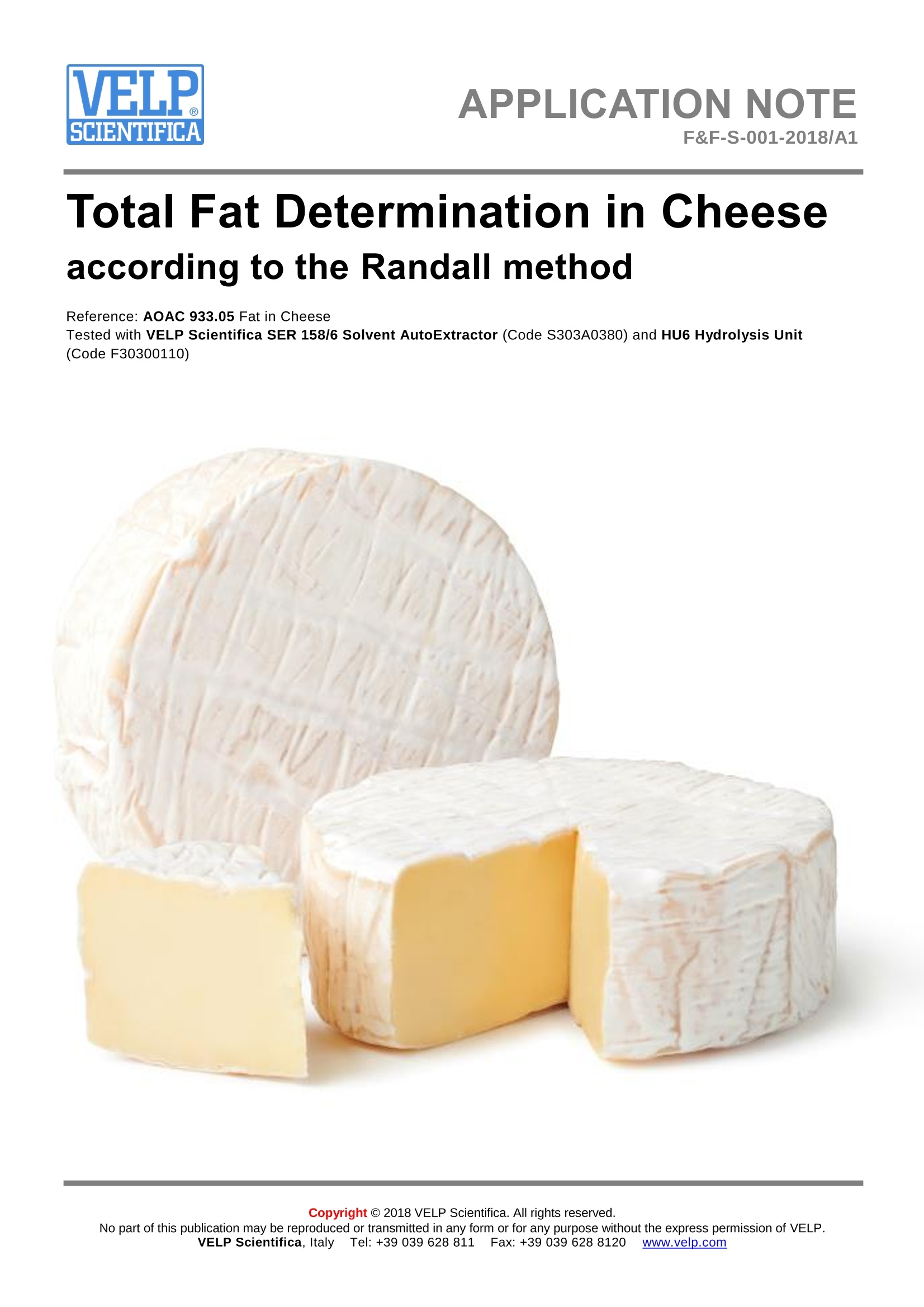
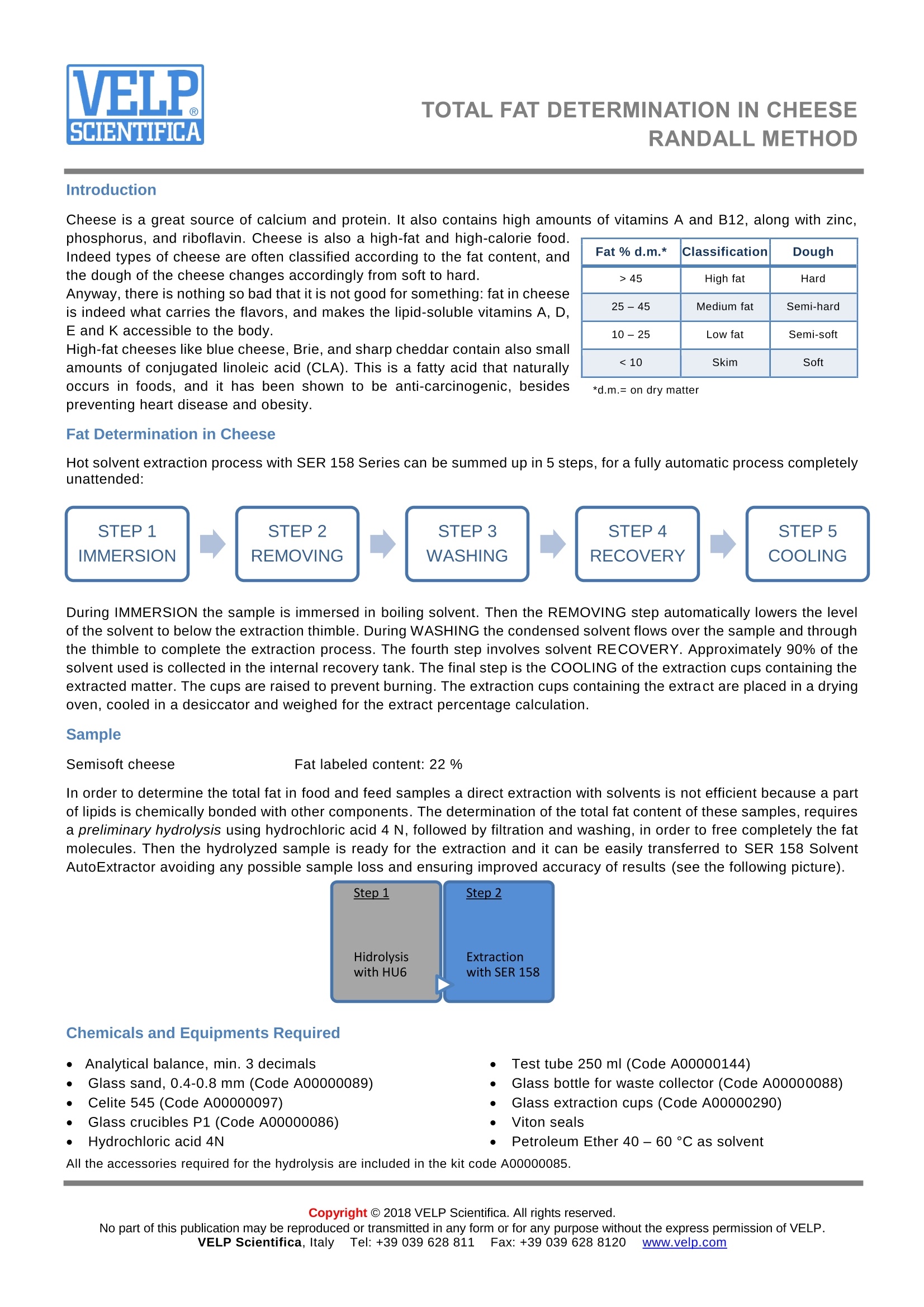
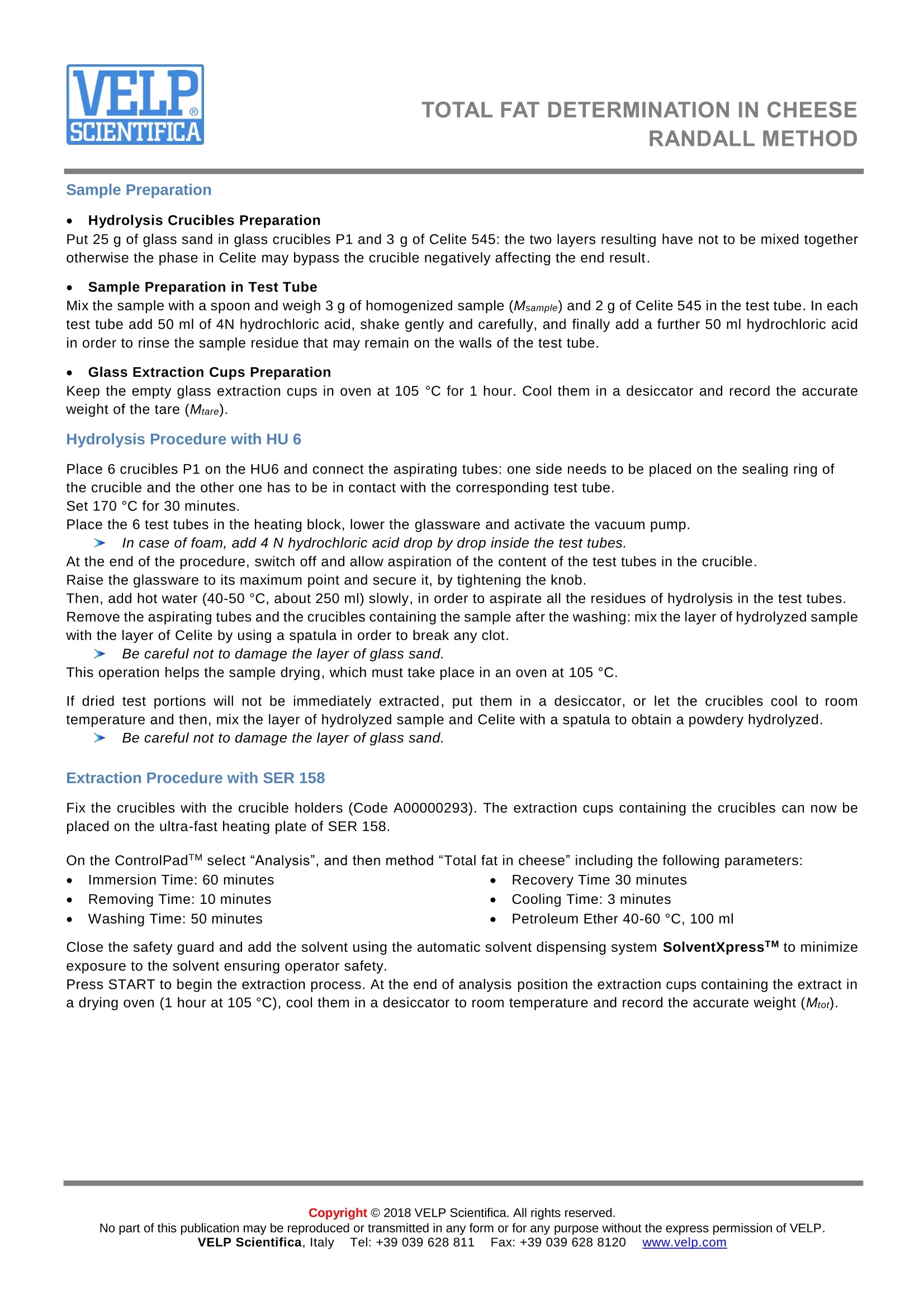
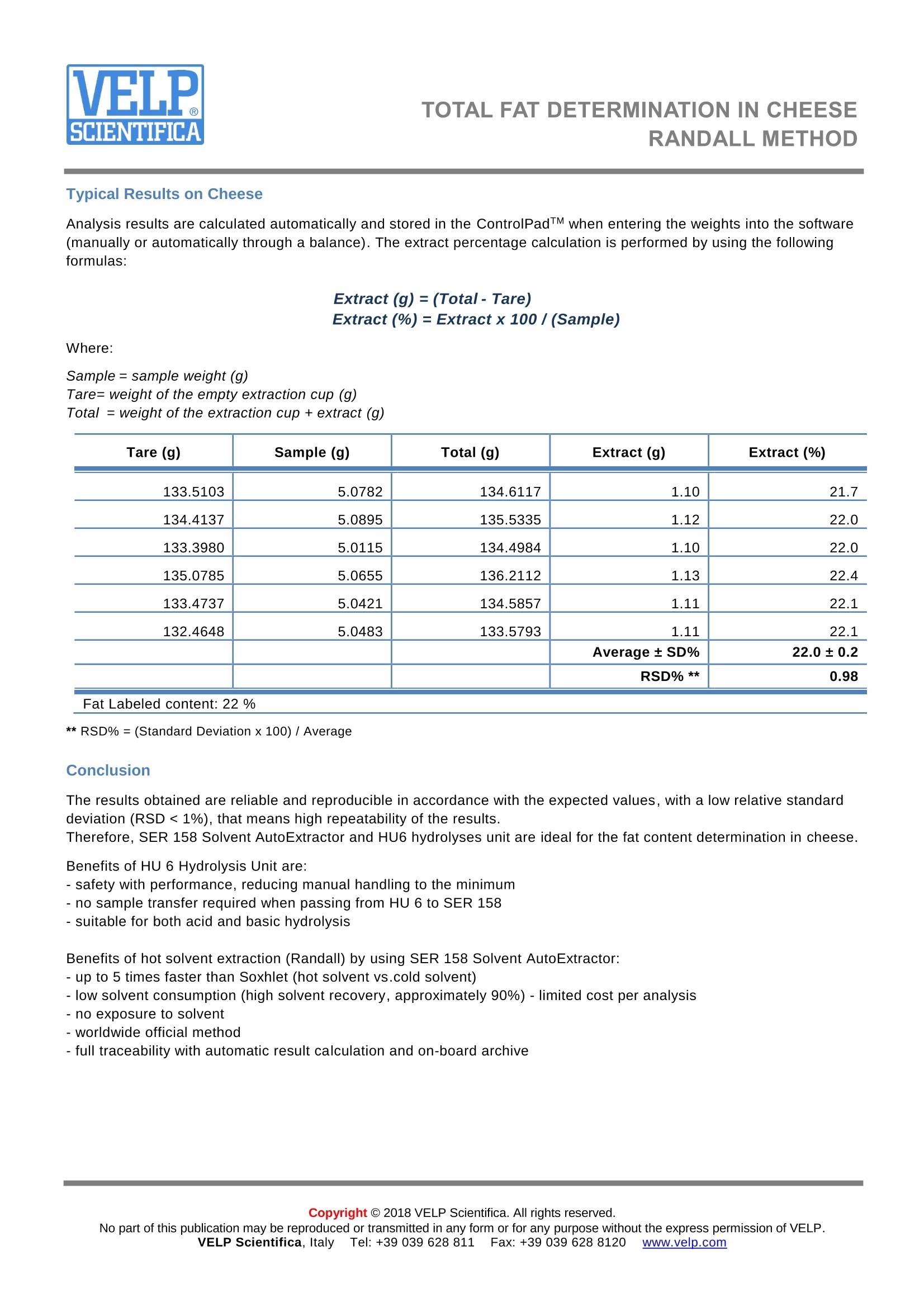
还剩2页未读,是否继续阅读?
北京盈盛恒泰科技有限责任公司为您提供《奶酪中总脂肪含量检测方案(抽提萃取)》,该方案主要用于其他乳制品中营养成分检测,参考标准--,《奶酪中总脂肪含量检测方案(抽提萃取)》用到的仪器有全自动脂肪测定仪-SER158
相关方案
更多
该厂商其他方案
更多

